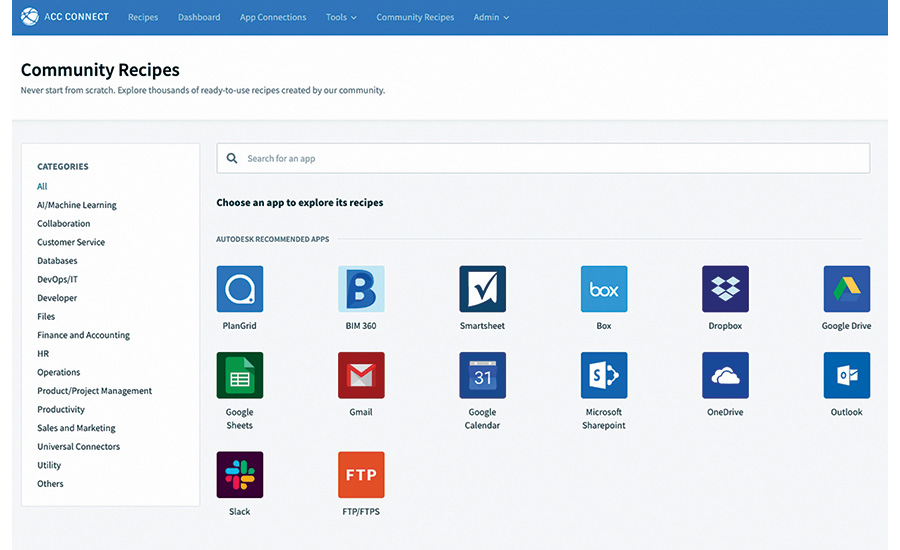Autodesk released an integration platform called Autodesk Construction Cloud Connect on May 27 that expands its cloud partner network and solidifies connections to other widely used construction software.
The software manufacturer also added new application program interfaces for BIM 360 and PlanGrid, and announced 15 new native software integrations for its platform, for a total of a 140 such integrations in the Autodesk Construction Cloud.
Using ACC Connect, contractors can build their own custom data integrations for their cloud-based Autodesk products without having to write new code. This data-sharing platform evolved out of PlanGrid Connect, which had allowed the PlanGrid app to communicate with other construction software platforms, prior to the company’s acquisition by Autodesk.
“Transferring data between the applications we use and those used by our clients and subcontractor partners can often be a complex, expensive, and error-prone process,” says Blaine Crawford, director of information technology at CW Driver, a Pasadena, Calif.-based contractor and construction manager.
CW Driver has been trying to streamline the sharing of its project data for the last six years. The company switched last year from a Windows server to an Egnyte cloud file server for all its project files.
“We needed a way to make sure that we had data on Egnyte synchronizing with PlanGrid,” Crawford says. CW Driver’s projects, such as the $64-million Cal State Dominguez Hills Innovation and Instruction Building, had become increasingly complex, with larger image files, drawings, documents, bulletins, CCDs and change orders all needing to flow from Egnyte to PlanGrid.
Crawford began discussions with Autodesk on how to make that happen last August. Using ACC Connect, CW Driver built an integration between Egnyte and PlanGrid for its regular project workflow.
“Now, that integration is on all new projects, and we are rolling out mobile in the field,” Crawford says. He noted that moving its project data to the cloud helped the contractor keep working during the COVID-19 pandemic.
Autodesk’s contractor customers that use BIM 360 now have the ability to integrate with construction applications including Agile Handover, Contecht, Matterport, MSuite, Plannerly, Reconstruct, Shedmate and SignNow. PlanGrid users now have integrations with DataStreet, Extracker, FACS, ProjectMates and Zters. Both BIM 360 and PlanGrid also now integrate with Allegion Overtur and StructionSite.
Cedar Rapids, Iowa-based MSuite provides cloud software BIMPro, FabPro and FieldPro, which manages building information models, fabrication and field construction of assemblies for trade contractors. Its integration connects BIM 360’s models directly to MSuite’s tools.
“When they’re looking at the model view, as soon as that model gets published, they’re going to see the update, but more importantly, our list is updated,” MSuite President Britton Langdon says. “Their work instructions get a revision. We’re able to track revision history. We’re able to track all of that.”
Langdon says a model of a carrier battery being fabricated for installation in the University of Iowa’s Kinnick Stadium as part of ongoing renovations can be tracked via BIM 360 and MSuite’s tools. “We are able to track in real time what stage of the process it’s in, how long it’s taking, whether or not it’s ahead or behind schedule and budget,” he says.
Better Data Flows Seen for Complex Projects
EBC, Inc. began using BIM 360 six years ago and has been using Microsoft’s Power BI to create visuals of its project data. The Montreal-based building and infrastructure contractor is working on major projects such as the University of Montreal’s new MIL Campus, and is also working in road and tunnel construction, civil engineering design and the mining sector.
The MIL Campus itself is a $350-million, 290-acre initiative. “It's really a university campus that was built specifically for medical sites,” says Phillipe De Guise, manager of corporate BIM services at EBC. “You've got rooms where they're actually going to be dissecting bodies. You've got rooms where scientists are going to be doing research. There's a tremendous amount of diversity or what the rooms are and what they're meant to be used for… you had so much diversity to be managing that, each room was like a new challenge.”
EBC is using some of the updates to BIM 360 to keep track of the complex project. The new integration streamlines the process of sharing visual dashboards and other data to project stakeholders through BIM 360.
“Project teams can now follow what’s happening on their project and so does EBC’s management committee,” De Guise says. “With the most recent updates and ever-evolving integrations, we are now habilitated to make some personalized and specific reports with the new data connectors and Power BI.”
The MIL Campus was the first project wherein EBC treated building elements as assets within BIM 360 and tracked them that way. “It's fairly new. It's fairly fresh that we've applied that [BIM 360 asset modules],” De Guise says. “With the coming of the new asset modules in BIM 360, it's a no brainer that it's going to be a big plus for all of our future projects.”
EBC had tracked equipment and materials as assets before the MIL project, but it had done so using processes that were more cumbersome.
“It was manually and there was a lot of waiting for information from other sources, from [Microsoft] Excel and after that, they would plug it into Bluebeam and all of that was very much manual,” says Nicolas St-Pierre, BIM manager for EBC’s buildings division. “Now, it's very much done automatically and mathematically within BIM 360."
In terms of what's next for software integrations, Autodesk says its strategy to connect with subcontractor and non-construction-focused programs like accounting and file-sharing software is still ongoing.
“The expansion of our integration capabilities underscores our commitment to driving construction productivity,” says Angi Izzi, director of partnerships for Autodesk Construction Solutions.






Post a comment to this article
Report Abusive Comment